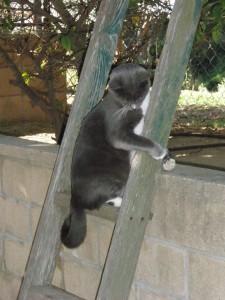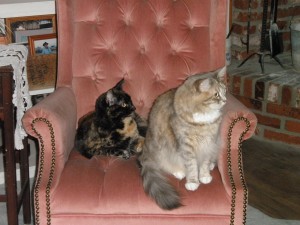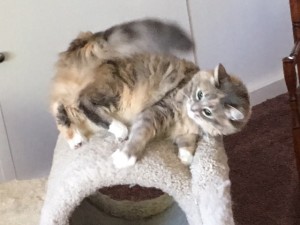 That was an interesting series of articles we ran this week on how Bobbi Florio Graham trains her cats. One has to wonder, is it training or conditioning and what is the difference? It seems that animals become conditioned to perform certain behaviors by repetition and triggers. For example, my mother’s cat, Smokey, knows when it’s bedtime or suppertime, based on what’s on TV. He’ll enter the room about suppertime or bedtime and look at the TV. Depending on what he sees or hears on the screen, he’ll either lay down and wait or urge my mother to go to the kitchen and feed him or nudge her to go to bed.
That was an interesting series of articles we ran this week on how Bobbi Florio Graham trains her cats. One has to wonder, is it training or conditioning and what is the difference? It seems that animals become conditioned to perform certain behaviors by repetition and triggers. For example, my mother’s cat, Smokey, knows when it’s bedtime or suppertime, based on what’s on TV. He’ll enter the room about suppertime or bedtime and look at the TV. Depending on what he sees or hears on the screen, he’ll either lay down and wait or urge my mother to go to the kitchen and feed him or nudge her to go to bed.
Likewise, Lily, our tabby, comes into the living room about half hour before her suppertime and lays at my feet. If I get up, she trots alongside my ankle as if she were a dog heeling and accompany me into the kitchen. If I’m not going to the kitchen, she tries to herd me in that direction.
Lily has an unexplained condition that causes twitching episodes. When she starts it, I hold my hand out and say, “Want scratchies? Want Mama to scratch you?” And she rushes to me, lays flat on the floor, and I scratch her back until she feels better. It’s pretty much a ritual around here…as is our bedtime routine. Lily leads the way now, instead of following, through the kitchen where we turn off lights and close blinds, then into the service porch where we lock the back door, then the bathroom, and bedroom. Before lights out, she checks her bowl of kibbles and lets me know if it’s low. How? By standing next to the bowl and staring at me—sometimes mewing.
 I’ve always thought that my cats trained me to adhere to their routine, preferences in food, sleeping places, etc., but Bobbi has given me a new perspective on my relationship and role with my cats. I realize they do understand the words we use regularly with them and certainly the gestures such as, “treat!” along with a stroll into the kitchen where the treats are kept. They also seem to understand, “supper,” and “bed.” I think our tortie, Sophie is confused, though. When she claws on a piece of furniture, I say a sharp, “No,” and she may or may not pay attention before I head in her direction to make her stop. But when she scratches on the cat tree and I tell her in my sweetest voice, “Good girl, Sophie. That’s a good girl,” she often stops the scratching and runs away. That one, I haven’t figured out.
I’ve always thought that my cats trained me to adhere to their routine, preferences in food, sleeping places, etc., but Bobbi has given me a new perspective on my relationship and role with my cats. I realize they do understand the words we use regularly with them and certainly the gestures such as, “treat!” along with a stroll into the kitchen where the treats are kept. They also seem to understand, “supper,” and “bed.” I think our tortie, Sophie is confused, though. When she claws on a piece of furniture, I say a sharp, “No,” and she may or may not pay attention before I head in her direction to make her stop. But when she scratches on the cat tree and I tell her in my sweetest voice, “Good girl, Sophie. That’s a good girl,” she often stops the scratching and runs away. That one, I haven’t figured out.
As you may know, I believe that cats can tune into our thoughts. Why else do they run and hide when you’ve scheduled a veterinarian appointment—and this is without the sound or sight of a carrier?
Just last night, I opened the freezer door where I keep catnip, along with ice cubes and a  lot of frozen food. I open that door at least once every few days. So why is it when I open it with the thought, “I think I’ll give the cats some catnip,” why do the cats become excited and dance around my feet? Sometimes they rush in from another room. How do they know?
lot of frozen food. I open that door at least once every few days. So why is it when I open it with the thought, “I think I’ll give the cats some catnip,” why do the cats become excited and dance around my feet? Sometimes they rush in from another room. How do they know?
I’d love to hear about some of your training or conditioning successes with your cats.






Hi Pat,
Try putting catnip on the scratching post and tinfoil on where you don’t want scratching. If they get the tinfoil it makes noises so they will not scratch there and the catnip they know is happiness. When you say, “No!” It helps if you tap them gently on the nose with one finger. Just enough to get their attention, never to hurt. I can point my finger and say no and my cats have always learned well what is acceptable and a hat isn’t.
I’d love to be part of your street team, although I’ve found very few errors in your books. Usually just a missing comma, part of a disjointed word or one repeated sentence. Thanks so much for keeping me entertained for the last week. Yes I read that fast. I love that you produce that fast with such interesting tales and suspence.
KAT